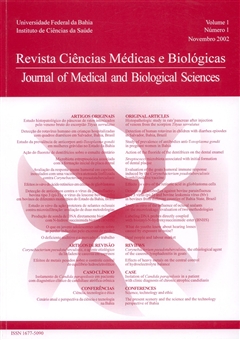Streptococci microbiota associated with initial formation of dental plaque
DOI:
https://doi.org/10.9771/cmbio.v1i1.4100Keywords:
Streptococci, dental plaque, adherence, oral biofilmAbstract
The identification and quantification of early streptococci that colonize the tooth surfaces in the complex biofilm of dental plaque, as well as the clear understanding of the functional relationship between them and other members are required before we can fully appreciate and possibly manage the processes that this initial community performs. Bacterial plaques were aseptically removed from teeth of healthy persons and experimentally inoculated onto sterilized dental units previously covered with sterile oral fluid. The inoculated dental unity (DU) was incubated at 37°C in a wet chamber. After the plaque formation, the DU was put in a solution (Detachment Plaque Solution -DPS) with 0.1% peptone water, 0.1% of Tween 80, and 0.5% calcinated sand (p/v). Then DU was submitted, successive and progressively, to five speed agitation levels. Aliquots of these solutions were collected and diluted in sterile phosphate buffer saline solution (PBS) immediately after each agitation.. In the period between each agitation the DU was softly washed in sterile PBS then inoculated in a new DPS solution. “In vivo” experiments were also performed using recently extracted teeth by using the same technique. Aliquots of dilutions were plated on the surface of appropriated media and spread by a sterile bent-glass rod. Inoculated plates were incubated at 37°C in anaerobic atmosphere. Plates were examined for 48 hours when the total and differential colonies were counted. Each colonial type was subcultured and submitted to the standard bacterial identification. A total of 86 Streptococcus cultures were studied. From these, 40.7 % were identified as S. sanguis, 37.2 % as S. oralis, 8.1% as S. mutans, 7.0% as S. gordonii, and 7.0% as other Streptococci. Analysis of the cultures isolated from the last speed agitation level showed that in the in vitro experiments only S. oralis (66.7%) and S. sanguis (33.3%) were present. In the “in vivo” experiments S. sanguis (56.5%) predominated, followed by S. oralis (21.7%), S. mutans (15.2%) and other streptococci (6.5%). The experiments performed to verify the ability of adhesion of seven cultures of isolated streptococci showed that only one strain of S. oralis and one strain of S. sanguis attached to the tooth surfaces.Downloads
Download data is not yet available.
Downloads
Published
2002-01-02
How to Cite
Almeida, P. F. de, Franca, M. P., Santos, S. P., Moreira, R. S., & Tunes, U. da R. (2002). Streptococci microbiota associated with initial formation of dental plaque. Journal of Medical and Biological Sciences, 1(1), 33–41. https://doi.org/10.9771/cmbio.v1i1.4100
Issue
Section
ORIGINAL ARTICLES
License
The Journal of Medical and Biological Sciences reserves all copyrights of published works, including translations, allowing, however, their subsequent reproduction as transcription, with proper citation of source, through the Creative Commons license. The periodical has free and free access.


